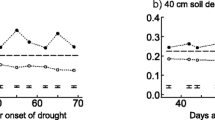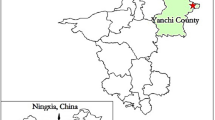Abstract
Recent control of atmospheric SO2 pollution is leading to important soil sulphur impoverishment. Plasticity could be a mechanism allowing species to adapt to this rapid global change. Trifolium repens L. is a key grassland species whose performances in community are strongly linked to nitrogen availability. Plasticity of three white clover lines contrasting in their ability to use atmospheric N2 or soil N was assessed by analysing a set of functional traits along a gradient of nitrogen and sulphur fertilisation applied on a poor soil. White clover traits showed high morphological and physiological plasticity. Nitrogen appeared to be the most limiting factor for the VLF (Very Low Fixation) line. S was the element that modulated the most traits for the nitrogen fixing lines NNU (Normal Nitrate Uptake) and LNU (Low Nitrate Uptake). As expected, N fertilisation inhibited white clover fixation, but we also observed that N2 fixation was enhanced when S was added. S fertilisation increased nodule length as well as the proportion of nodules containing leghaemoglobin. S fertilisation, with a direct effect and an indirect effect through N2 fixation, increases white clover performances particularly with regards to photosynthesis and potential vegetative reproduction. The important plasticity in response to S availability should allow it to adapt to a large range of abiotic conditions, but its sensitivity to S nutrition would be a disadvantage for competition in a situation of soil sulphur impoverishment. In contrast, S fertilisation could help maintain this species when nitrogen status is against it.



Similar content being viewed by others
References
Abberton MT, Michaelson-Yeates TPT, Macduff JH (1998) Characterization of novel inbred lines of white clover (Trifolium repens L.). I. Dynamics of plant growth and nodule development in flowing solution culture. Euphytica 103:35–43. doi:10.1023/A:1018317902636
Ahmad A, Abdin MZ (2000) Photosynthesis and its related physiological variables in the leaves of Brassica genotypes as influenced by sulphur fertilisation. Physiol Plant 110:144–149. doi:10.1034/j.1399-3054.2000.110119.x
Aulakh MS, Dev G, Arora BR (1976) Effect of sulphur fertilization on the nitrogen–sulphur relationships in alfalfa (Medicago sativa L. Pers.). Plant Soil 45:75–80. doi:10.1007/BF00011130
Blake-Kalff MMA, Harrison KR, Hawkesford MJ, Zhao FJ, McGrath SP (1998) Distribution of sulfur within oilseed rape leaves in response to sulphur deficiency during vegetative growth. Plant Physiol 118:1337–1344. doi:10.1104/pp.118.4.1337
Bradshaw AD (1965) Evolutionary significance of phenotypic plasticity in plants. Adv Genet 13:115–155. doi:10.1016/S0065-2660(08)60048-6
Caradus JR, Hay MJM, Mackay AD, Thomas VJ, Dunlop J, Lambert MG, Hart AL, Van den Bosch J, Wewala S (1993) Variation within white clover (Trifolium repens L.) for phenotypic plasticity of morphological and yield related characters, induced by phosphorus supply. New Phytol 123:175–184
Ceccotti SP, Messick DL (1997) A global review of crop requirements, supply, and environmental impact on nutrient sulphur balance. In: Cram WJ, De Kok LJ, Stulen I, Brunold C, Rennenberg H (eds) Sulphur metabolism in higher plants. Backhuys, Leiden, pp 155–163
DeBoer DL, Duke SH (1982) Effects of sulphur nutrition on nitrogen and carbon metabolism in lucerne (Medicago sativa L.). Physiol Plant 54:343–350. doi:10.1111/j.1399-3054.1982.tb00269.x
Dijkshoorn W, Van Wijk AL (1967) The sulphur requirements of plants as evidenced by the sulphur–nitrogen ratio in the organic matter. A review of published data. Plant Soil 26:129–157. doi:10.1007/BF01978680
Fismes J, Vong PC, Guckert A, Frossard E (2000) Influence of sulfur on apparent N-use efficiency, yield and quality of oilseed rape (Brassica napus L.) grown on a calcareous soil. Eur J Agron 12:127–141. doi:10.1016/S1161-0301(99)00052-0
Frankow-Lindberg BE (1999) Effects of adaptation to winter stress on biomass production, growth and morphology of three contrasting white clover cultivars. Physiol Plant 106:196–202. doi:10.1034/j.1399-3054.1999.106208.x
Gautier H, Varlet-Grancher C, Membré JM (2001) Plasticity of petioles of white clover (Trifolium repens) to blue light. Physiol Plant 112:293–300. doi:10.1034/j.1399-3054.2001.1120219.x
Gilbert SM, Clarkson DT, Cambridge M, Lambers H, Hawkesford MJ (1997) SO4 2− deprivation has an early effect on the content of ribulose-1,5-biphosphate caboxylase/oxygenase and photosynthesis in young leaves of wheat. Plant Physiol 115:1231–1239
Grime JP, Hodgson JG, Hunt R (1988) Comparative plant ecology. Unwyn-Hyman, London
Habtemichial KH, Singh BR (2007) Wheat response to N2 fixed by faba bean (Vicia faba L.) as affected by sulphur fertilization and rhizobial inoculation in semi-arid Northern Ethiopia. J Plant Nutr Soil Sci 170:412–418. doi:10.1002/jpln.200625006
Haneklaus S, Bloem E, Schnug E (2003) The global sulphur cycle and its links to plant environment. In: Abrol YP, Ahmad A (eds) Sulphur in plants. Kluwer Academic, Dordrecht, pp 1–28
Haynes RJ (1980) Competitive aspects of the grass-legume association. Adv in Agron 33:227–261
Hogh-Jensen H (2003) The effect of potassium deficiency on growth and N2-fixation in Trifolium repens. Physiol Plant 119:440–449. doi:10.1034/j.1399-3054.2003.00189.x
Imsande J (1998) Iron, sulfur, and chlorophyll deficiencies: a need for an integrative approach in plant physiology. Physiol Plant 103:139–144. doi:10.1034/j.1399-3054.1998.1030117.x
Jacquemyn H, Brys R, Hermy M (2003) Short-term effects of different management regimes on the response of calcareous grassland vegetation to increased nitrogen. Biol Conserv 111:137–147. doi:10.1016/S0006-3207(02)00256-2
Kalia VC, Drevon JJ (1985) Variation in nitrogenase activity (C2H2 reduction) during the in situ incubation of root nodules of Glycine max (L.) Merr. Compt Rend Acad Sci Ser III 301:591–596
Karmoker JL, Clarkson DT, Sarker LR, Rooney JM, Purves JV (1991) Sulphate deprivation depresses the transport of nitrogen to the xylem and the hydraulic conductivity of barley (Hordeum vulgare L.) roots. Planta 185:269–278. doi:10.1007/BF00194070
Macduff H, Jarvis SC, Davidson IA (1996) Inhibition of N2 fixation by white clover (Trifolium repens L.) at low concentrations of NO3 − in flowing solution culture. Plant Soil 180:287–295. doi:10.1007/BF00015312
Mathot M, Mertens J, Verlinden G, Lambert R (2008) Positive effects of sulphur fertilisation on grasslands yields and quality in Belgium. Eur J Agron 28:655–658. doi:10.1016/j.eja.2007.12.004
Michaelson-Yeates TPT, Macduff JH, Abberton MT, Raistrick N (1998) Characterization of novel inbred lines of white clover (Trifolium repens L.). II. Variation in N2 fixation, NO3 − uptake and their interactions. Euphytica 103:45–54. doi:10.1023/A:1018369919474
Morton JD, Smith LC, Metherell AK (1999) Pasture yield response to phosphorus, sulphur and potassium applications on North Otago soils, New Zealand. N Zeal J Agr Res 42:133–146
Mosquera-Losada MR, Gonzalez-Rodriguez A, Rodriguez AR (2004) Fertilization with nitrogen and potassium on pastures in temperate areas. J Range Manage 57:280–290. doi:10.2307/4003797
Murphy MD, Boggan JM (1988) Sulphur deficiency in herbage in Ireland 1. Causes and extent. Ir J Agric Food Res 27:83–90
Murphy MD, Quirke WA (1997) The effect of sulphur/nitrogen/selenium interactions on herbage yield and quality. Ir J Agric Food Res 36:31–38
Navas ML, Garnier E (2002) Plasticity of whole plant and leaf traits in Rubia peregrina in response to light, nutrient and water availability. Acta Oecol 23:375–383. doi:10.1016/S1146-609X(02)01168-2
Noble IR, Slatyer RO (1980) The use of vital attributes to predict successional changes in plant communities subject to recurrent disturbances. Vegetatio 43:5–21. doi:10.1007/BF00121013
Pigliucci M, Murren CJ, Schlichting CD (2006) Phenotypic plasticity and evolution by genetic assimilation. J Exp Biol 209:2362–2367. doi:10.1242/jeb.02070
Piper JK (1995) Composition of prairie plant-communities on productive versus unproductive sites in wet and dry years. Can J Bot 73:1635–1644. doi:10.1139/b95-177
Rausch T, Wachter A (2005) Sulfur metabolism: a versatile platform for launching defence operations. Trends Plant Sci 10:503–509. doi:10.1016/j.tplants.2005.08.006
Scherer HW (2001) Sulphur in crop production. Eur J Agron 14:81–111. doi:10.1016/S1161-0301(00)00082-4
Scherer HW, Lange A (1996) N2 fixation and growth of legumes as affected by sulphur fertilization. Biol Fertil Soils 23:449–453. doi:10.1007/BF00335921
Scherer HW, Pacyna S, Spoth KR (2008) Low levels of ferredoxin, ATP and leghemogobin contribute to limited N2 fixation of peas (Pisum sativum L.) and Alfalfa (Medicago sativa L.) under S deficiency conditions. Biol Fertil Soils 44:909–916. doi:10.1007/s00374-008-0273-7
Schlichting CD (1986) The evolution of phenotypic plasticity in plants. Annu Rev Ecol Syst 17:667–693. doi:10.1146/annurev.es.17.110186.003315
Simon JC, Leconte D, Vertès F, Le Meur D (1997) Maîtrise de la pérennité du trèfle blanc dans les associations. Fourrages 152:483–498
Sokal RR, Rohlf FJ (2003) Biometry, 3rd edn. Freeman, New York
Soussana JF, Minchin FR, Macduff JF, Raistrick N, Abberton MT, Michaelson-Yeates TPT (2002) A simple model of feed-back regulation for nitrate uptake and N2 fixation in contrasting phenotypes of white clover. Ann Bot (Lond) 90:139–147. doi:10.1093/aob/mcf161
Sultan SE (2004) Promising directions in plant phenotypic plasticity. Perspect Plant Ecol Evol Syst 6:227–233. doi:10.1078/1433-8319-00082
Sultan SE (2005) An emerging focus on plant ecological development. New Phytol 166:1–5. doi:10.1111/j.1469-8137.2005.01381.x
Tallec T, Diquélou S, Lemauviel S, Cliquet JB, Lesuffleur F, Ourry A (2008) Nitrogen: Sulphur ratio alters competition between Trifolium repens and Lolium perenne under cutting: production and competitive abilities. Eur J Agron 29:94–101.
Via S, Gomulkiewicz R, De Jong G, Scheiner SM, Schlichting CD, Van Tienderen PH (1995) Adaptative phenotypic plasticity: consensus and controversy. Trends Ecol Evol 10:212–217. doi:10.1016/S0169-5347(00)89061-8
Violle C, Navas ML, Vile D, Kazakou E, Fortunel C, Hummel I, Garnier E (2007) Let the concept of trait be functional!. Oikos 116:882–892. doi:10.1111/j.0030-1299.2007.15559.x
Weiher E, Van der Werf A, Thompson K, Roderick M, Garnier E, Eriksson O (1999) Challenging Theophrastus: a common core list of plant traits for functional ecology. J Veg Sci 10:609–620. doi:10.2307/3237076
Zhao FJ, Evans EJ, Bilsborrow PE, Syers JK (1993) Influence of sulphur and nitrogen on seed yield and quality of low glucosinolate oilseed rape (Brassica napus L.). J Sci Food Agr 63:29–37
Zhao FJ, Wood AP, McGrath SP (1999) Effects of sulphur nutrition on growth and nitrogen fixation of pea (Pisum sativum L.). Plant Soil 212:209–219. doi:10.1023/A:1004618303445
Acknowledgements
We are grateful to Marie-Paule Bataillé for technical assistance in isotopic analysis.
Author information
Authors and Affiliations
Corresponding author
Additional information
Responsible Editor: Euan K. James.
Rights and permissions
About this article
Cite this article
Varin, S., Lemauviel-Lavenant, S., Cliquet, J.B. et al. Functional plasticity of Trifolium repens L. in response to sulphur and nitrogen availability. Plant Soil 317, 189–200 (2009). https://doi.org/10.1007/s11104-008-9800-4
Received:
Accepted:
Published:
Issue Date:
DOI: https://doi.org/10.1007/s11104-008-9800-4




